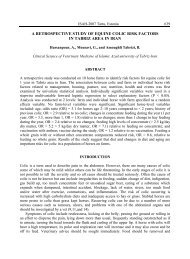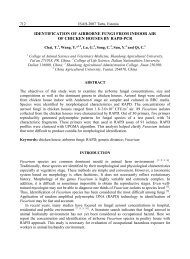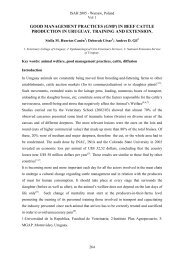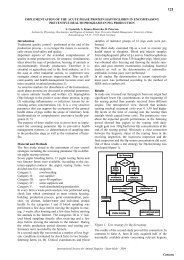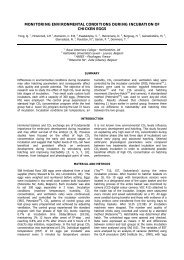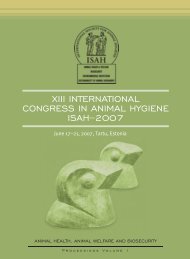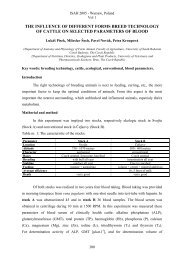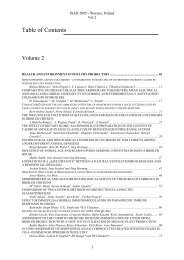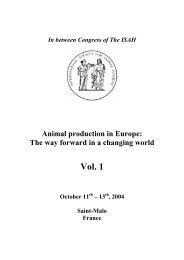EFFECTS OF THE INTRODUCTION OF LACTIC ACID ... - ISAH-SOC
EFFECTS OF THE INTRODUCTION OF LACTIC ACID ... - ISAH-SOC
EFFECTS OF THE INTRODUCTION OF LACTIC ACID ... - ISAH-SOC
You also want an ePaper? Increase the reach of your titles
YUMPU automatically turns print PDFs into web optimized ePapers that Google loves.
<strong>ISAH</strong>-2007 Tartu, Estonia 309<br />
The aim of this study is to test the effect of this lactic acid bacteria based product regarding the<br />
growth performances and the digestive flora equilibrium balance during the rearing and the<br />
influence on the microbiological quality of the carcasses at the processing level.<br />
MATERIAL AND METHODS<br />
Animals<br />
5000 “Ross” broilers were divided into 15 batches distributed over 3 experimental treatments.<br />
Each treatment was replicated five times with 250 animals in each floor pen leading to a stocking<br />
density of 16 animals/m 2 .<br />
Lactic complement<br />
The lyophilised lactic acid bacterial strain was added to the drinking water. The birds of the<br />
treatment 1 (T1) received 10 5 cfu/ml, and those of the treatment 2 (T2) received 10 6 cfu/ml, while<br />
in the control treatment (T0); the animals did not receive the product.<br />
Animal performances<br />
Animal growth performances were recorded by weighing a sample of 30 animals by floor pen at<br />
7, 21 and 36 days. Feed intake and feed efficiency of each floor pen were estimated from the<br />
difference between the total quantity of feed distributed and the weight of the remaining feed at 7,<br />
21 and 36 days.<br />
Microbiological analyses<br />
For the study of the digestive flora, 15 animals from each treatment (3 per floor pen) were<br />
euthanized for faecal content sampling in order to follow the amount of total coliforms, C.<br />
perfringens, Enterococcus and Lactic acid bacteria at the rearing level. At the processing plant<br />
level, 15 samples of each treatment were taken from neck and thigh skins. On these samples,<br />
thermophilic coliforms, S. aureus, Pseudomonas and Lactic acid bacteria were enumerated the<br />
day of slaughter. After 7 days chilling at 4°C Pseudomonas and Lactic acid bacteria were<br />
enumerated on neck skins.<br />
Statistical analyses<br />
The effects of the feed complement were tested using when possible the parametric test Anova<br />
followed by Tukey’s test. When the conditions of normality and homogeneity of the variances are<br />
not completed, the non parametric test of Kruskall-Wallis was performed followed by Mann and<br />
Whitney’s test in case of significant differences between the treatments<br />
RESULTS<br />
Growth performances<br />
The administration of the lactic product did not show any significant effect (p=0.698) between 0<br />
and 7 days on the daily weight gain (DWG): the control and treated animals presented a DWG<br />
around 19 g/animal/day (table 1). Between 7 and 21 days, animals treated with 10 5 cfu/ml showed<br />
a significant higher DWG (p=0.090) than the other animals. Despite the lack of statistical



